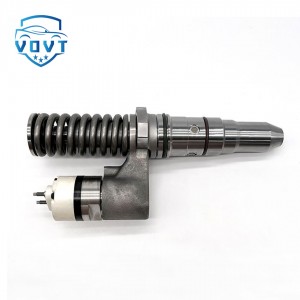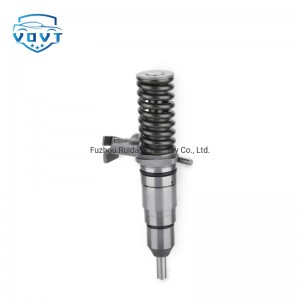New High Quality Diesel Injector 116-5414 116-8899 128-8510 147-0373 194-5083 For CAT C12
Products Description
| Reference. Codes | C12 |
| Application | C12 |
| MOQ | 4PCS |
| Certification | ISO9001 |
| Place of Origin | China |
| Packaging | Neutral packing |
| Quality Control | 100% tested before shipment |
| Lead time | 7~10 working days |
| Payment | T/T, L/C, Paypal, Western Union, MoneyGram or as your requirement |
What impact will a fuel injector failure have on vehicle performance?
Difficulty in starting or failure to start
Reason: Injector blockage, leakage or solenoid valve failure will lead to insufficient fuel injection or abnormal injection timing.
Blockage: Carbon deposits or impurities block the spray hole, the fuel cannot be sprayed normally, and the combustible mixture in the cylinder is too lean.
Leakage: Poor seal of the injector causes continuous dripping of fuel, too much fuel (too rich) or insufficient pressure in the cylinder.
Performance:
The engine shakes and the speed is unstable when starting, and it takes multiple ignitions to start.
In severe cases, the fuel cannot enter the cylinder, causing the vehicle to be completely unable to start.
Power reduction and weak acceleration
Reason:
Insufficient injection volume: Injector wear or blockage makes the actual injection volume lower than the ECU (engine control unit) setting value, and the energy generated by combustion is insufficient.
Poor atomization: The spray hole wears and becomes larger or carbon deposits cause the fuel atomization particles to be coarse, not fully mixed with the air, and the combustion efficiency is reduced.
Performance:
The throttle response is slow during driving, the vehicle speed increases slowly during acceleration, and the power is obviously insufficient when climbing or overtaking.
The maximum speed decreases when driving at high speed, and the engine power cannot be fully exerted.
Abnormal increase in fuel consumption
Reason:
Leakage or dripping: The injector is not closed tightly, resulting in continuous fuel leakage, which consumes fuel even if the engine is not running.
Poor injection atomization: The fuel enters the cylinder without being fully atomized, and the unburned fuel is discharged with the exhaust gas ("fuel waste").
Imbalanced mixture ratio: The ECU may be forced to increase the fuel supply to correct the injection amount (such as when the mixture is too lean).
Performance:
The vehicle's fuel consumption per 100 kilometers is significantly higher than the normal level (such as an increase of 1-3L or more).
The dashboard of some models will display an "abnormal fuel consumption" warning.
Engine shaking and unstable idling
Reason:
Uneven injection amount of each cylinder: Failure of individual injectors causes inconsistent combustion energy between cylinders and unbalanced engine force.
Intermittent injection failure: The injector solenoid valve is stuck or the circuit contact is poor, resulting in intermittent fuel injection.
Performance:
The engine shakes noticeably at idle speed, and the steering wheel or body can feel vibration.
The idle speed fluctuates ("wandering" phenomenon), and may even stall.
Excessive emissions and abnormal exhaust gas
Reason:
Incomplete combustion: Poor atomization or abnormal fuel injection leads to incomplete combustion of fuel, producing a large amount of pollutants such as CO (carbon monoxide) and HC (hydrocarbons).
Misfire in missing cylinder: When the injector is completely blocked, the corresponding cylinder does not work, and the unburned fuel is directly discharged, which aggravates pollution.
Performance:
The exhaust smell is pungent (such as a strong gasoline smell), and black or blue smoke (accompanied by burning oil) can be seen by the naked eye.
If the exhaust emission test does not meet the standard during the annual inspection, the OBD system may store "misfire" or "emission control system failure" code.
Other related effects
Accelerated formation of carbon deposits:
Poor fuel atomization will cause the fuel to adhere to the cylinder wall or combustion chamber, forming carbon deposits, further aggravating the blockage of the injector and the wear of valves, piston rings and other components.
Increased fuel pump load:
Injector leakage will cause the fuel system pressure to drop, and the fuel pump needs to work frequently to maintain the pressure, which may shorten the service life of the pump.
Fault light alarm:
The ECU of most models will monitor the injector circuit or working status. When a fault occurs, the dashboard "engine fault light" (CHECK ENGINE) will light up and store the fault code (such as P0201-P0204, corresponding to 1-4 cylinder injector circuit faults).
How to determine the injector fault?
Diagnostic tool: Use OBD tester to read the fault code, combine with fuel pressure gauge to detect system pressure, and oscilloscope to measure the injector signal waveform.
Simple troubleshooting:
The stethoscope monitors whether the "clicking" sound of the injector is uniform when working.
Disassemble and inspect the spark plugs to observe whether the electrodes show signs of fuel wetness (leakage) or dryness (blockage).
Troubleshooting suggestions
Minor blockage: Carbon deposits can be removed by non-disassembly cleaning (such as bottle cleaning or special fuel additives).
Serious leakage or jamming: The injector needs to be disassembled for ultrasonic cleaning, or directly replaced with a new part (especially leakage caused by aging of the rubber seal).
Circuit failure: Check whether the injector harness plug is loose or short-circuited, and repair or replace the harness.
Timely handling of injector failures can not only restore vehicle performance, but also reduce fuel consumption, reduce emission pollution, and avoid larger problems such as severe engine wear caused by minor failures.





















